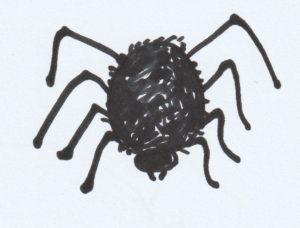
From as far back as I can remember, I was absolutely scared stiff of spiders. I’m pretty sure my phobia was ‘learnt’ from my mum. When you’re little and you see an adult appearing terrified, you naturally assume that whatever it is they’re scared of must be pretty awful!
Then, once when lying in bed at night, a spider ran over my pillow just a few centimetres from my face. Following that time, I was unable to sleep in any room that had a spider in it. And I even hated having to sleep in rooms with lots of furniture and ‘nooks and crannies’ where they might be hiding.
Things didn’t get any better as an adult. If I had a particularly near encounter, I would feel physically sick. Just looking at a picture of a spider made me shudder, and in direct proportion to their size and hairiness. And, live spiders were much worse, particularly if they moved! There was something about their unpredictability – if they ran away, I was left with the knowledge that they could reappear later; if they ran towards me, there was the horrific prospect they might touch me. I was completely dependent on someone else being around to remove any spiders that came into my vicinity.
I remember the day when things began to change for me. It was when I realised that I could use my Alexander Technique skills to lessen my fear. I’d just walked into a room when I experienced the familiar sudden shock of seeing a large spider. What struck me most was not so much the spider itself but my strong fear reaction with all its physical and emotional manifestations. It occurred to me that the Alexander Technique is all about dealing with our reactions, so was it possible that I had some small degree of choice here? I realised that I was already beginning the process of calming myself down enough to see that I did have some options.
I decided to experiment and I began by placing myself at what felt like a ‘safe’ distance from the spider. Just looking at it from there made my skin start to crawl and my stomach churn, so I turned away and worked with my usual Alexander thinking, such as noticing the support, thinking up from there through my whole self, staying engaged with my surroundings. In particular, I paid attention to my breath which was very rapid and shallow. I imagined gently blowing a feather that was hovering just in front of my lips. At the end of each outbreath I noticed that natural little pause and then the inbreath flowing in by itself. I noticed my breathing was now calming and deepening. When I felt ready, I slowly turned to look back again at the hairy creature, knowing that I could look away again as soon as my fear started to mount. I kept repeating this process, turning away, giving my Alexander directions, calming my breath, looking back for as long as I wanted to and turning away again as soon as I felt the fear reaction begin to take hold. After a while, I found I could continue to look at the spider (which thankfully stayed stationary) without feeling scared. That was the beginning for me and I continued to use this process whenever I encountered a spider, or just a picture of one. Gradually I found I could deal with bigger and bigger ones, and even spiders that moved!
I don’t know anything about exposure therapy and I’m sure there will be some similarities in approach to what I did. What I think will be unique about learning and practising the Alexander Technique, is the degree of agency and control it can enable, as well as the fact that you can apply it in any situation. Research has shown that the Alexander Technique can lead to reduced fear and anxieties more generally.[1] It makes sense because, after all, it’s really hard to change anything about yourself unless you feel safe and in control of the situation – the Alexander Technique provides the means to create your own safety.
So what happens now when I see a spider? Little ones, or those big spindly ones? – no problem at all and I would happily pick it up. A big hairy house spider? Well, I would still have an initial fear reaction but much less than before. Then I’m able to quickly quieten my reaction as I take my time to carefully put an upturned glass over it and carry it outside (yes, I do know that it probably just comes back in again); I’m ok with that. PS. Please don’t test me out with a tarantula – I’m not sure I’m quite ready yet for a real one of those ‘up close and personal’!
Reference
- Kinsey D, Glover L, Wadephul F. How does the Alexander Technique lead to psychological and non-physical outcomes? A realist review. European Journal of Integrative Medicine 2021; 46: https://doi.org/10.1016/j.eujim.2021.101371.

